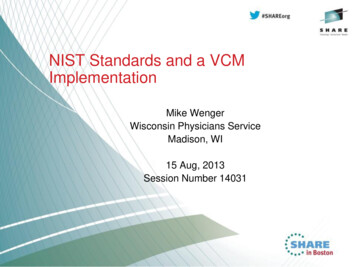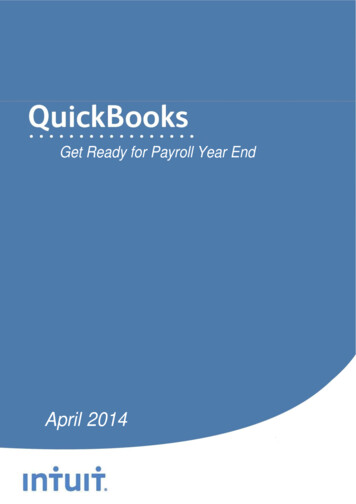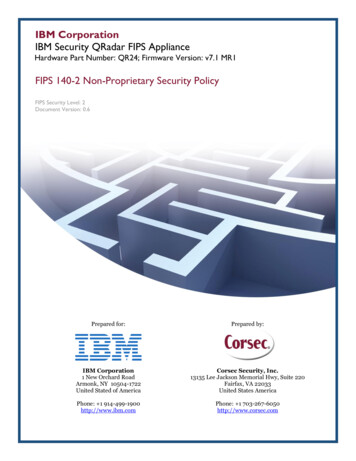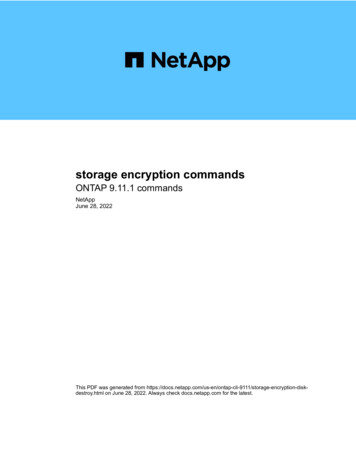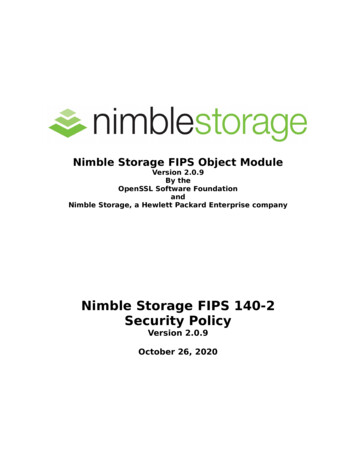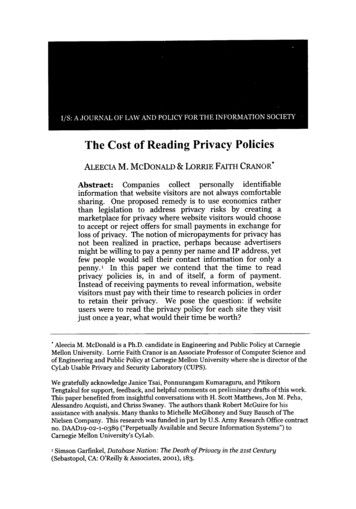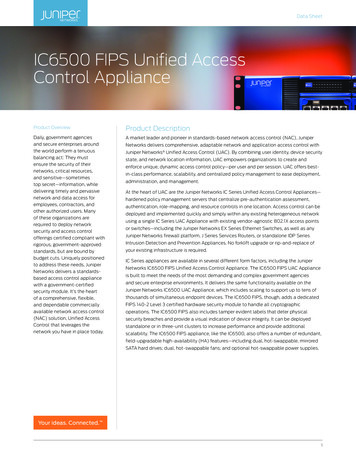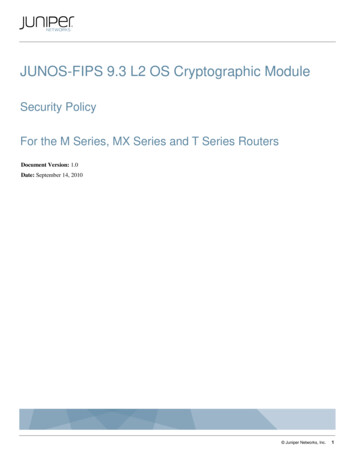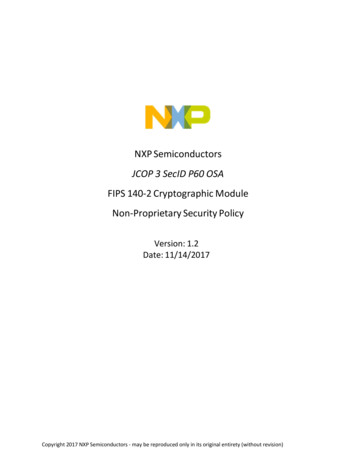
Transcription
NXP SemiconductorsJCOP 3 SecID P60 OSAFIPS 140‐2 Cryptographic ModuleNon‐Proprietary Security PolicyVersion: 1.2Date: 11/14/2017Copyright 2017 NXP Semiconductors ‐ may be reproduced only in its original entirety (without revision)
NXP SemiconductorsJCOP 3 SecID P60 OSA FIPS 140‐2 Security PolicyTable of ContentsReferences. 3Acronyms and definitions . 41 Introduction . 51.1 Versions, Configurations and Modes of Operation . 51.2 Hardware and Physical Cryptographic Boundary . 61.3 Firmware and Logical Cryptographic Boundary . 72 Cryptographic Functionality . 82.1 Critical Security Parameters and Public Keys . 93 Roles, Authentication and Services. 103.1 Secure Channel Protocol Authentication Method . 103.2 Services. 114 Self‐test . 134.1 Power‐On Self‐tests . 134.2 Conditional self‐tests . 135 Physical Security Policy . 146 Electromagnetic interference and compatibility (EMI/EMC). 147 Mitigation of Other Attacks Policy . 148 Security Rules and Guidance . 14List of TablesTable 1: References . 3Table 2: Acronyms and Definitions . 4Table 3: Security Level of Security Requirements . 5Table 4: Product version indicator . 6Table 5: FIPS mode indicator. 6Table 6: Ports and Interfaces . 7Table 7: Approved algorithms. 8Table 8: Non‐Approved but Allowed Cryptographic Functions . 8Table 9: Critical Security Parameters . 9Table 10: Public Keys . 9Table 11: Roles Supported by the Module . 10Table 12: Services. 11Table 13: Service Access to CSPs . 12Table 14: Power‐On Self‐Tests . 13Table 15: Conditional Self‐Tests . 13List of FiguresFigure 1: NXP Semiconductors P6022y VB . 6Figure 2: Module Block Diagram . 7Copyright NXP Semiconductors, 2017Page 2 of 14Version 1.2NXP Semiconductors Public Material – may be reproduced only in its original entirety (without revision)
NXP SemiconductorsJCOP 3 SecID P60 OSA FIPS 140‐2 Security PolicyReferencesAcronymFull Specification NameApproved Algorithm [67][90A]NIST, Recommendation for Key Derivation Using Pseudorandom Functions, October 2009.NIST, Secure Hash Standard (SHS), FIPS Publication 180‐4, August 2015.NIST, Digital Signature Standard (DSS), FIPS Publication 186‐4, July 2013.NIST, Advanced Encryption Standard (AES), FIPS Publication 197, November 26, 2001.NIST, Recommendation for Block Cipher Modes of Operation ‐ Methods and Techniques,December 2001.NIST, Recommendation for Block Cipher Modes of Operation: The CMAC Mode forAuthentication, May 2005.NIST, Recommendation for Block Cipher Modes of Operation: Methods for Key Wrapping,December 2012.NIST, Recommendation for Pair‐Wise Key Establishment Schemes Using Discrete LogarithmCryptography, Revision 2, May 2013.NIST Special Publication 800‐67, Recommendation for the Triple Data Encryption Algorithm(TDEA) Block Cipher, version 1.2, July 2011NIST, Recommendation for Random Number Generation Using Deterministic Random BitGenerators, Revision 1, June 2015.Other References[Annex A][Annex C][Annex d][PKCS#1][131A]NIST, Approved Security Functions, September 2015.NIST, Approved Random Number Generators, February 2012.NIST, Approved Key Establishment Techniques, October, 2014.NIST, Derived Test Requirements [DTR] for FIPS PUB 140‐2, Security Requirements forCryptographic Modules, January 2011.NIST, Security Requirements for Cryptographic Modules, May 25, 2001GlobalPlatform Consortium: GlobalPlatform Card Specification 2.1.1, March 2003,http://www.globalplatform.orgGlobalPlatform Consortium: GlobalPlatform Card Specification 2.1.1 Amendment A, March 2004NIST, Implementation Guidance for FIPS PUB 140‐2 and the Cryptographic Module ValidationProgram, December 28 2015.ISO/IEC 7816‐1: 1998 Identification cards ‐‐ Integrated circuit(s) cards with contacts ‐‐ Part 1:Physical characteristicsISO/IEC 7816‐2:2007 Identification cards ‐‐ Integrated circuit cards ‐‐ Part 2: Cards with contacts‐‐ Dimensions and location of the contactsISO/IEC 7816‐3:2006 Identification cards ‐‐ Integrated circuit cards ‐‐ Part 3: Cards with contacts‐‐ Electrical interface and transmission protocolsISO/IEC 7816‐4:2005 Identification cards ‐‐ Integrated circuit cards ‐‐ Part 4: Organization,security and commands for interchangeJava Card 2.2.2 Runtime Environment (JCRE) SpecificationJava Card 2.2.2 Virtual Machine (JCVM) Specification JavaCard 2.2.2 Application Programming InterfacePublished by Sun Microsystems, March 2006PKCS #1 (IETF RFC3447): Public‐Key Cryptography Standards (PKCS) #1: RSA CryptographySpecifications Version 2.1, February 2003.Transitions: Recommendation for Transitioning the Use of Cryptographic Algorithms and KeyLengths, November 2015.Table 1: ReferencesCopyright NXP Semiconductors, 2017Page 3 of 14Version 1.2NXP Semiconductors Public Material – may be reproduced only in its original entirety (without revision)
NXP SemiconductorsJCOP 3 SecID P60 OSA FIPS 140‐2 Security PolicyAcronyms and definitionsAcronymDefinitionAPDUApplication Protocol Data Unit, see [ISO 7816]APIApplication Programming InterfaceCMCard Manager, see [GlobalPlatform]CRNGTContinuous random number generator test, see [DTR] AS09.42CSPCritical Security Parameter, see [FIPS 140‐2]DAPData Authentication Pattern, see [GlobalPlatform]DPADifferential Power AnalysisGPGlobal PlatformHIDHuman Interface Device (Microsoftism)ICIntegrated CircuitISDIssuer Security Domain, see [GlobalPlatform]JCOPJavaCard Open PlatformKATKnown Answer TestNDRNGNon‐deterministic random number generatorNVMNon‐Volatile Memory (e.g. EEPROM, Flash)PCTPairwise Consistency TestPKIPublic Key InfrastructureSCPSecure Channel Protocol, see [GlobalPlatform]SPASimple Power AnalysisTPDUTransaction Protocol Data Unit, see [ISO 7816]Table 2: Acronyms and DefinitionsCopyright NXP Semiconductors, 2017Page 4 of 14Version 1.2NXP Semiconductors Public Material – may be reproduced only in its original entirety (without revision)
NXP Semiconductors1JCOP 3 SecID P60 OSA FIPS 140‐2 Security PolicyIntroductionThis document defines the Security Policy for the NXP Semiconductors JCOP 3 SecID P60 (OSA)cryptographic module, hereafter denoted the Module. The Module, validated to FIPS 140‐2 overall Level3, is a single chip module implementing the Global Platform operational environment, with the CardManager.The Module is a limited operational environment under the FIPS 140‐2 definitions. The Module includesa firmware load function to support necessary updates. New firmware versions within the scope of thisvalidation must be validated through the FIPS 140‐2 CMVP. Any other firmware loaded into this moduleis out of the scope of this validation and requires a separate FIPS 140‐2 validation.The FIPS 140‐2 security levels for the Module are as follows:Security RequirementSecurity LevelCryptographic Module Specification3Cryptographic Module Ports and Interfaces3Roles, Services, and Authentication3Finite State Model3Physical Security4Operational EnvironmentN/ACryptographic Key Management3EMI/EMC3Self‐Tests3Design Assurance3Mitigation of Other Attacks3Table 3: Security Level of Security Requirements1.1Versions, Configurations and Modes of OperationThe Module is available in four configurations:Product 86400J3H145000586400EEPROMInterface80 kByteContact80 kByteDual144 kByte144 kByteContactHW VersionFW VersionP6022y VB0503.8211DualThe variations in EEPROM size and interface support are achieved by enabling or disabling the featureson a common die design, permanently set at the factory during a fabrication step.Copyright NXP Semiconductors, 2017Page 5 of 14Version 1.2NXP Semiconductors Public Material – may be reproduced only in its original entirety (without revision)
NXP SemiconductorsJCOP 3 SecID P60 OSA FIPS 140‐2 Security PolicyTo verify the version of the firmware, use the context service to select the card Manager and the Infoservice (GET DATA APDU, tag ‘9F7F’) to verify the fields shown next.Data ElementLengthValueAssociated VersionIC fabricator20x4790NXP P6022y VBIC type20x0503Firmware Version Part 1Operating system identifier20x8211Firmware Version Part 2Operating system release date20x6057Firmware release dateOperating system release level20x0002Firmware release level (the first byte is thepatch level)Table 4: Product version indicatorTo verify that the Module runs in the Approved mode of operation, use the context service to select thecard Manager and the Info service (GET DATA APDU, tag ‘88’) to verify the field shown in Table 5 belowData ElementFIPS ComplianceLength2Value‘xxxx’ (where ‘A5F0’ or ‘3BC4’ is FIPS DISABLED. Any othervalue is FIPS ENABLED)Table 5: FIPS mode indicator1.2Hardware and Physical Cryptographic BoundaryThe Module is designed to be embedded into plastic card bodies, with a contact plate and contactlessantenna connections. The physical form of the Module is depicted in Figure 1 (to scale); the red outlinedepicts the physical cryptographic boundary, representing the surfaces and edges of the integratedcircuit die and the associated bond pads. The cross‐hatching indicates the presence of active tampershields. In production use, the Module is delivered to either vendors or end user customers in variousforms: As bare die in wafer form for direct chip assembly by wire bonding or flip chip assembly.Wire bonded and encapsulated by epoxy with additional packaging e.g. Dual Interface Modules;Contact only Modules; Contactless Modules; SMD packages.The contactless ports of the module require connection to an antenna. The Module relies on ISO 7816and ISO 14443 compliant card readers as input/output devices.Figure 1: NXP Semiconductors P6022y VBCopyright NXP Semiconductors, 2017Page 6 of 14Version 1.2NXP Semiconductors Public Material – may be reproduced only in its original entirety (without revision)
NXP SemiconductorsPortJCOP 3 SecID P60 OSA FIPS 140‐2 Security PolicyDescriptionLogical Interface TypeCDVCC, GNDISO 7816: Supply voltagePowerXXRSTISO 7816: ResetControl inXXCLKISO 7816: ClockControl inXXI/OISO 7816: Input/OutputControl in, Data in, Data out, Status outXXLA, LBISO 14443: AntennaPower, Control in, Data in, Data out, Status outNCNot connectedXNot connectedTable 6: Ports and InterfacesIn the table above, an “X” in the C column indicates the port is active in the Contact mode; an “X” in theD column indicates the port is active in the Dual interface (Contact and contactless) mode.1.3Firmware and Logical Cryptographic BoundaryFigure 2 depicts the Module operational environment.CardManagerAppletGlobal PlatformFirmware PlatformJavaCard APIJCOP OSHardwareVCC, gineTimersSensorsEEPROMRSA/ECCEngineISO 7816(UART)ResetMgmtROMHW RNGISO 14443(RF)CPUI/O(Contact)LA/LB (RF)Figure 2: Module Block DiagramCopyright NXP Semiconductors, 2017Page 7 of 14Version 1.2NXP Semiconductors Public Material – may be reproduced only in its original entirety (without revision)
NXP Semiconductors2JCOP 3 SecID P60 OSA FIPS 140‐2 Security PolicyCryptographic FunctionalityThe Module implements the Approved and Non‐Approved but Allowed cryptographic functions listed inTable 7 and Table 8 below.CAVPAlgorithmAES [197], [38A]3997[38B]Mode/MethodStrength1CBC, ECB128, 192, 256CMAC3997 KTS [38F]AES/AES‐CMAC824 ECC CDH [56A]1187 DRBG [90A]P‐224, P‐256, P‐384, P‐521Hash DRBG256P‐224 P‐256 P‐384 P‐521P‐224: (SHA‐224), P‐256: (SHA‐256)P‐521: (SHA‐512)P‐192: (SHA‐1) P‐224: (SHA‐224) P‐256: (SHA‐256) P‐521: (SHA‐512)CTR128, 192, 256n 2048, {n 3072}n 2048 SHA(224,256,384,512)n 2048 SHA(1,224,256,384,512){n 1024 SHA(1,224,256,384) }SHA‐1, SHA‐2 (224, 256, 384, 512)TCBC, TECB3‐Key (112)890ECDSA [186]91 KBKDF [108]2086 RSA [186]2053 RSA [186]3299 SHS [180]2195 Triple‐DES [67]Triple‐DES MACVA2[113](128, 192, 256)3‐Key (112)UsageData encryption and decryptionCMAC generation and verificationMeets the SP 800‐38F §3.1 ¶3requirements for symmetric keywrapping, using Cert. #3397 AES andAES CMAC.Shared secret generationRandom bit generationECC Key GenerationDigital signature generationDigital signature verificationKey derivationKey generationDigital signature generationDigital signature verificationMessage digest generationData encryption, decryptionMAC generation, verification.Table 7: Approved algorithmsReferences to standards are given in square bracket [ ]; see the References table.Items in curly brackets { } are CAVP tested but not used by the module.AlgorithmNDRNG12DescriptionHardware NDRNG; used as entropy input (384 bits) to the FIPS approved (Cert.#1187) DRBG.The non‐deterministic hardware RNG outputs 8 bits per access, buffered by thedevice driver, which performs the continuous RNG test when a 32‐bit value isavailable.Table 8: Non‐Approved but Allowed Cryptographic Functions“Strength” indicates DRBG Strength, Key Lengths, Curves or ModuliVendor Affirmed, using Cert. #2195 primitivesCopyright NXP Semiconductors, 2017Page 8 of 14Version 1.2NXP Semiconductors Public Material – may be reproduced only in its original entirety (without revision)
NXP Semiconductors2.1JCOP 3 SecID P60 OSA FIPS 140‐2 Security PolicyCritical Security Parameters and Public KeysAll CSPs used by the Module are described in this section. All usages of these CSPs by the Module aredescribed in the services detailed in Section 4. In the tables below, the OS prefix denotes operatingsystem, the SD prefix denotes the Global Platform Security Domain, the DAP prefix denotes the GlobalPlatform Data Authentication Protocol, and the APP prefix denotes an Applet CSP.Table 9: Critical Security ParametersTable 10: Public KeysCopyright NXP Semiconductors, 2017Page 9 of 14Version 1.2NXP Semiconductors Public Material – may be reproduced only in its original entirety (without revision)
NXP Semiconductors3JCOP 3 SecID P60 OSA FIPS 140‐2 Security PolicyRoles, Authentication and ServicesThe Module: Does not support a maintenance role.Clears previous authentications on power cycle.Supports Global Platform SCP logical channels, allowing concurrent operators in a limitedfashion.Authentication of each operator and their access to roles and services is as described below,independent of logical channel usage. Only one operator at a time is permitted on a channel. Applet de‐selection (including Card Manager), card reset or power down terminates the current authentication.Re‐authentication is required after any of these events for access to authenticated services.Authentication data is encrypted during entry (by SD‐KDEK), is stored in plaintext and is only accessibleby authenticated services.Table 11 lists all operator roles supported by the Module.Role IDRole DescriptionCOCryptographic Officer – role that manages Module content and configuration, includingissuance and management of Module data via the ISD. Authenticated as described inSecure Channel Protocol Authentication below.UserThe Applet Developer User ‐ Considered an internal, privileged user of the platform.Entities in this role create and deploy smart card applets that utilize JavaCard APIs as theonly means of communicating with OS internals. The Applet Developer User is in charge ofinstalling and managing their own applications in their respective Application ProviderSecurity Domain (APSD) on the card. Authenticated as described in Secure Channel ProtocolAuthentication below.Table 11: Roles Supported by the Module3.1Secure Channel Protocol Authentication MethodThe Secure Channel Protocol authentication method is provided by the Secure Channel service. The SD‐KENC and SD‐KMAC keys are used to derive the SD‐SENC and SD‐SMAC keys, respectively. The SD‐SENCkey is used to create a cryptogram; the external entity participating in the mutual authentication alsocreates this cryptogram. Each participant compares the received cryptogram to the calculatedcryptogram and if this succeeds, the two participants are mutually authenticated (the external entity isauthenticated to the Module in the CO role).The probability that a random attempt will succeed using this authentication method is: 1/2 128 2.9E‐39 (for any of AES‐128/192/256 SD‐KENC/SD‐SENC, assuming a 128‐bit block)This authentication method includes a counter of failed authentication called “velocity checking” byGlobalPlatform. The counter is decremented prior to any attempt to authenticate and is only reset to itsthreshold (maximum value) upon successful authentication.The Module enforces a maximum of 80 failed SCP authentication attempts before blocking the card. Theprobability that a random attempt will succeed over a one minute interval is: 80/2 128 2.4E‐37 (for any of AES‐128/192/256 SD‐KENC/SD‐SENC, assuming a 128‐bit block)Copyright NXP Semiconductors, 2017Version 1.1Page 10 of 14NXP Semiconductors Public Material – may be reproduced only in its original entirety (without revision)
NXP Semiconductors3.2JCOP 3 SecID P60 OSA FIPS 140‐2 Security PolicyServicesAll services implemented by the Module are listed in the tables below. The ISD Services are provided bythe module or Card Manager and are available to off card entities. Such services are related to cardcontent management (e.g., applet loading, installation, deletion, card data access or storage) accessedvia communication protocols like ISO7816. The API Services are available to on card entities, i.e., JavaCard applets. These services are typically cryptographic services available via the Java Card API.Table 12: ServicesTable 13 below describes the access to CSPs by service with brief descriptions next are intended to helpreaders understand the patterns of access. Explanations are provided in groups of services and/or keys(as best suited to explain the pattern of access), describing first those aspects that have commonalityacross services or keys/CSPs.Lifecycle: must be used with Secure Channel active (hence SD Session keys are ‘E’); zeroizes all keysexcept session keys when Lifecycle is used for card termination.OS‐MKEK: generated on first power‐up of the Module in a manufacturing setting; used whenever anyprivate or secret key is accessed; zeroized on Lifecycle card termination.OS‐DRBG CSPs: OS‐DRBG‐EI is the NDRNG entropy input to the DRBG instantiation at power‐on (ModuleReset), zeroized after use. OS‐DRBG‐STATE is generated at startup (Module Reset), zeroized at shutdownas part of Module Reset, or by LifeCycle card termination. Each ‘EW’ in the OS‐DRBG‐STATE columnindicates the use of the DRBG to generate keys (or nonces), as the value is used and the state isupdated.Secure Channel Master Keys (SD‐KENC, SD‐KMAC): ‘E’ when a secure channel is initialized (GP SecureChannel, PKI Applet Secure Channel, TWNID Applet GP Secure Channel). May be updated (‘W’) using theManage Content service; zeroized by Lifecycle card termination. SD‐KDEK is used to decrypt CSPsentered into the module.Secure Channel Session Keys (SD‐SENC, SD‐SMAC, SD‐RMAC): ‘E’ for any service that can be used withsecure channel active. ‘GE’ on GP Secure Channel, PKI Applet Secure Channel and TWNID Applet GPSecure Channel as a consequence of secure channel initialization and usage; however, while the SD‐RMAC key is generated by default, the PKI Applet Secure Channel and TWNID Applet GP Secure Channelservices do not use it). ‘Z’ on Module Reset is a consequence of RAM clearing/garbage collection.Copyright NXP Semiconductors, 2017Version 1.1Page 11 of 14NXP Semiconductors Public Material – may be reproduced only in its original entirety (without revision)
NXP SemiconductorsJCOP 3 SecID P60 OSA FIPS 140‐2 Security PolicyDAP‐PUB is imported into the module at the factory, but may be updated using the Manage Contentservice. It is used by the Manage Content for signature verification of patch or applet code.All API services may potentially be used with an active secure channel. The Asymmetric key generationservice is used for ECC or RSA key generation; public keys are typically output in the service response.The Authentication service provides AES CMAC or Triple‐DES MAC generation and verification, withaccess to the corresponding secret key. The Digital signature service provides ECDSA or RSA signaturegeneration and verification; ECDSA signature generation utilizes a random value. The Shared secretgeneration provides the SP 800‐56A §5.7.1.2 ECC CDH function, using the local private key and theexternal participant’s public key to generate the shared secret. The Symmetric cipher service providesAES and Triple‐DES encryption and decryption. The symmetric key generation service providesgeneration of AES or Triple‐DES keys.Table 13: Service Access to CSPs G Generate: The Module generates the CSP.R Read: The Module reads the CSP (read access to the CSP by an outside entity).E Execute: The Module executes using the CSP.W Write: The Module writes the CSP (overwrite of an existing CSP).Z Zeroize: The module zeroizes the CSP. For the Context service, SD session keys are destroyedon applet deselect (channel closure)‐‐ Not accessed by the serviceCopyright NXP Semiconductors, 2017Version 1.1Page 12 of 14NXP Semiconductors Public Material – may be reproduced only in its original entirety (without revision)
NXP Semiconductors4JCOP 3 SecID P60 OSA FIPS 140‐2 Security PolicySelf‐test4.1Power‐On Self‐testsOn power‐on or reset, the Module performs self‐tests as described in Table 14 below. All KATs must becompleted successfully prior to any other use of cryptography by the Module. If one of the KATs fails,the system is halted and will start again after a reset.Test TargetCert. #Description3997Performs separate encrypt and decrypt KATs using an AES‐128 key in CBCmode.3997Performs AES CMAC generate and verify KATs using an AES‐128 key.1187Performs a fixed input KAT and all SP 800‐90A health test monitoringfunctions.ECC CDHCVL 824Performs an ECC CDH KAT using the ECC P‐256 curve.ECDSA890Performs separate ECDSA signature and verify KATs using the P‐256 curve.AESAES CMACDRBGFWIntegrity16 bit CRC performed over all code located in EEPROM. This integrity test isnot required or performed for code stored in masked ROM code memory.KBKDF91Performs a fixed input KAT on SP 800‐108 AES CMAC based KBKDFRSA2053Performs separate RSA signature and verify KATs using an RSA 2048‐bit key.SHA‐13299Performs a fixed input KAT.SHA‐2563299Performs a fixed input KAT (inclusive of SHA‐224, per IG 9.4)SHA‐5123299Performs a fixed input KAT (inclusive of SHA‐384, per IG 9.4).Triple‐DES2195Performs encrypt and decrypt KATs using 3‐Key Triple‐DES in CBC mode.Table 14: Power‐On Self‐Tests4.2Conditional self‐testsTest TargetDRBG CRNGTFW LoadGenerate PCTNDRNG CRNGTSignature PCTDescriptionOn every call to the DRBG, the Module performs the AS09.42 continuous RNG testto assure that the output is different than the previous value.When new firmware is loaded into the Module using the LOAD command, theModule verifies the integrity of the new firmware (applet) using RSA SignatureVerification with the DAP‐PUB public key; the new firmware in this scenario issigned by an external entity using the private key corresponding to DAP‐PUB.Pairwise consistency test performed when an asymmetric key pair is generated forRSA or ECC.AS09.42 continuous RNG test performed on each 32 bits access from the NDRNG(buffered by the driver) to assure that the output is different than the previousvalue.Pairwise consistency test performed when a signature is generated for RSA orECDSA.Table 15: Conditional Self‐TestsCopyright NXP Semiconductors, 2017Version 1.1Page 13 of 14NXP Semiconductors Public Material – may be reproduced only in its original entirety (without revision)
NXP Semiconductors5JCOP 3 SecID P60 OSA FIPS 140‐2 Security PolicyPhysical Security PolicyThe Module is a single‐chip implementation that meets commercial‐grade specifications for power,temperature, reliability, and shock/vibrations. The Module uses standard passivation techniques and isprotected by active shielding (a grid of top metal layer wires with tamper response). A tamper eventdetected by the active shield places the Module permanently into the Tamper is detected error state.The Module is intended to be mounted in additional packaging; physical inspection of the die is typicallynot practical after packaging.6Electromagnetic interference and compatibility (EMI/EMC)The Module conforms to the EMI/EMC requirements specified by part 47 Code of Federal Regulations,Part 15, Subpart B, Unintentional Radiators, Digital Devices, Class B.7Mitigation of Other Attacks PolicyThe module is protected against SPA, DPA, Timing Analysis and Fault Induction using a combination offirmware and hardware counter‐measures. Protection features include detection of out‐of‐range supplyvoltages, frequencies or temperatures3, and detection of illegal address or instruction. All cryptographiccomputations and sensitive operations such as PIN comparison provided by the module are designed tobe resistant to timing and power analysis. Sensitive operations are performed in constant time,regardless of the execution context (parameters, keys, etc.), owing to a combination of hardware andfirmware features.8Security Rules and GuidanceThe Module implementation enforces the following security rules: The Module does not output CSPs (plaintext or encrypted).The Module does not support manual key entry.The Module does not output intermediate key values.No additional interface or service is implemented by the Module which would provideaccess to CSPs.Data output is inhibited during key generation, self‐tests, zeroization, and error states.There are no restrictions on which CSPs are zeroized by the zeroization service.Status information does not contain CSPs or sensitive data that if misused could leadto a compromise of the Module.3FIPS 140‐2 defines EFP in Level 4; in this submission, the platform vendor declined to performadditional testing beyond Level 3 and what was already performed for Common Criteria validation.Copyright NXP Semiconductors, 2017Version 1.1Page 14 of 14NXP Semiconductors Public Material – may be reproduced only in its original entirety (without revision)
The Module, validated to FIPS 140‐2 overall Level 3, is a single chip module implementing the Global Platform operational environment, with the Card Manager. The Module is a limited operational environment under the FIPS 140‐2 definitions. The Module includes a firmware load function to support necessary updates.
